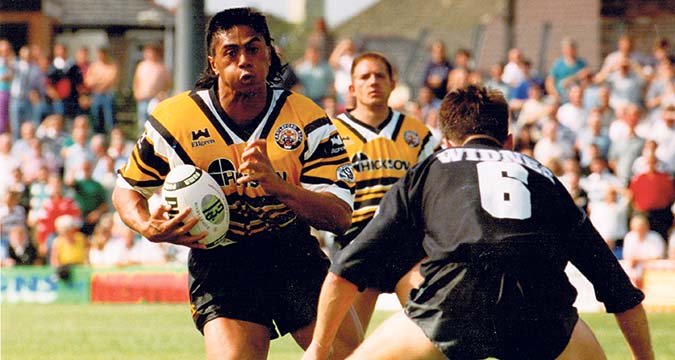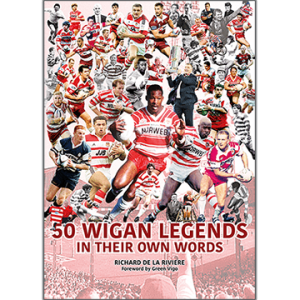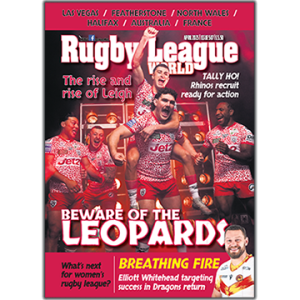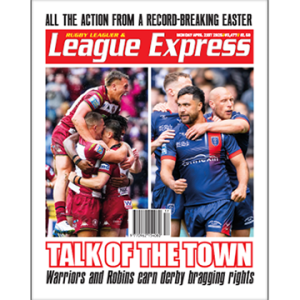
A brilliant loose forward from the late 1980s to the early 2000s, Tawera Nikau made a huge impact at Castleford, Cronulla, Melbourne and Warrington after brief spells at Sheffield and Ryedale-York.
Sporting one of Rugby League’s great mullets, he starred for the Kiwis before captaining Aotearoa Maori in their only World Cup appearance in 2000.
Few have experienced turmoil like him, though, and the way he recovered from the events of 2001 and 2003 demonstrates what a remarkable individual Tawera Nikau is.
If you could relive one day from your career, which would it be?
I had a lot of special times, but playing for Castleford was wonderful, so I’ll go for beating Wigan 33-2 in the 1994 Regal Trophy Final at Headingley. It was just one of those games when everything was perfect. Everybody in the team played to their potential and that doesn’t often happen.
What are your memories of playing for Sheffield Eagles and Ryedale-York in 1990 and 1991?
I toured with the Kiwis in 1989 and was approached by Gary Hetherington, who was running Sheffield. So Francis Leota and I signed up for a short stint and thoroughly enjoyed ourselves. I’d grown up watching great Kiwis like James Leuluai, Dane O’Hara, Gary Kemble and Fred Ah Kuoi playing overseas, so it was nice to do likewise.
Then Gary Stephens from York approached me about joining them the following year, where I played alongside James. I have some great memories of both clubs. I was very sad to hear of the death of Geoff Pryce recently. He was a real stalwart of the York club, and I’d like to pass my condolences to his wife and family.
You were New Zealand’s man of the series against Great Britain in 1990. What are your memories of the series?
I was always fascinated with English players, especially the big forwards and with Mal Reilly coaching, they had some tough players like Kelvin Skerrett and Roy Powell.
Unfortunately, we lost the series, but it was so close. Garry Schofield was the difference. He had spiders on him. He was throwing dummies, scoring tries and kicking drop goals.
If it wasn’t for him, we’d have won all three Tests. He was a class act and had a stellar career.
Tell us more about your days at Castleford.
I loved it there. When my wife and I visited the club, it reminded us of our hometown Huntly, a coal-mining town. They had some great players like Lee Crooks, Graham Steadman and St John Ellis.
Darryl van de Velde was a fantastic coach and so was John Joyner when he took over. John had played all his life with Cas and could get the best out of us.
Going to Wembley in 1992 was special. Walking down the tunnel was so unique. You could just see light at the end. You’d hear a roar and see the packed terraces. It was such a long walk. It’s like the gladiators going into the arena.
I played a Test there in 1993, but it wasn’t the same when it wasn’t full. I played in front of an even bigger crowd in the 1999 NRL Grand Final, but nothing touches Wembley. We lost to Wigan that day, but they were the benchmark back then and had a big advantage by being full time.
What are the highlights of your Kiwi career?
Everyone remembers their first cap and I led the haka, so the first Test against Great Britain in 1990 is one I’ll always remember. Then there’s beating Australia in Melbourne in 1991 in Wally Lewis’s last Test. They had so many legends like Mal Meninga, Alfie Langer, Bob Lindner and Blocker Roach, so we were the underdogs, and we had a young side. I actually scored!
You would have played in more internationals, including the 1995 World Cup, had it not been for your feud with Richie Blackmore. Do you regret that?
I have no regrets over the decisions I made at the time. That’s just where I was and what I thought was best. But Richie and I have discussed things and we get on well now. I maybe could have done things differently and it would have been nice to play a few more Tests.
Your next port of call was Cronulla. Did the 1997 Super League Grand Final against Brisbane feel like a real Grand Final, given what was happening in the Australian game?
Yes, very much so. They were also one of the best teams I ever faced with Langer, Lockyer, Webcke, Sailor, Walters, Renouf etc. They were like Wigan. We’d beaten them 32-4 earlier in the year, so we were pretty confident, but they had too much for us in the final and Renouf scored a hat-trick, despite Andrew Ettingshausen marking him.
I really enjoyed my time at the Sharks. We made the semi-finals in each season. The football was quicker and more defence-orientated. Johnny Lang was a great coach and Andrew Ettingshausen, Les Davidson and Paul Green were outstanding players.
You then moved to Melbourne for 1998 and were part of their maiden season.
Joining Melbourne was quite surreal. John Ribot sold me the vision of the club. He wanted to create a powerhouse club and we exceeded expectations. We had a lot of young guys like Brett Kimmorley, Scott Hill and Richard Swain, who didn’t worry about reputations. We came third and were beaten by the Broncos in the semi-final.
A year later, you helped the Storm win the Grand Final. Can you still visualise the penalty-try incident at the end? How did you go about overturning a 14-0 half-time deficit? And do you agree with many observers that you should have won the Clive Churchill Medal?
I remember the penalty try very well. I’d taken a hit-up on the left and played the ball. I turned around and it was like slow motion. Brett Kimmorley kicked to the corner. Stephen Kearney was running through. I saw Craig Smith going through the air and though, “He’s going to score!” Then I thought he’d dropped the ball and that was that. But Billy Harrigan sent it to the video ref. I hadn’t seen the high tackle on Craig, but when I saw the replay on the big screen, you could see he’d been taken out. Billy had the video ref in his ear and suddenly Lazzo walked over and told us we were getting the penalty try. We still had four minutes to play, but we managed to hold out.
I remember looking at the scoreboard as I walked off at half-time. 14-0 down. But we had come from behind against Parramatta and Canterbury in the two previous games, so we knew we could do it. We had some great leadership at the club, and we knew if we kept plugging away, we could come back. [Coach] Chris Anderson told us not to worry. We got into some rhythm and got some points on the board and finished strongly.
I still get people saying that I should have won the Clive Churchill, but I’m just glad I won a Premiership, regardless of who won the man of the match. So many players don’t win one. It took the Brisbane Broncos five seasons to do it and we did it in two. It was special to win the last one of the Millennia, and in front of a world-record crowd.
You captained the New Zealand Maoris in the 2000 World Cup. You had an excellent side. Should you have gone further?
I’d played for the Maoris many years earlier and we beat Great Britain in 1996. It was very humbling to captain them. Cameron and Dean Bell were the coaches and quite a few players went on to play for New Zealand. I was disappointed not to go further, but we lost to Samoa and Ireland in the pool games and that was that.
What attracted you back to England with Warrington in 2000?
I loved the English atmosphere, so it was great to return. Our plan was to do two or three seasons at Warrington and then get into coaching. Expectations were high with signings like Alfie Langer and Andrew Gee, but we played Bradford in two Challenge Cup semi-finals and lost them both. They reminded me of the old Wigan side. Alfie was a great player, and we had a great time there.
Your wife Letitia took her own life in 2001. How did you cope and how long did it take to come to terms with such a tragedy?
It was the most harrowing experience possible. Letitia was my wife and also my manager. It was so hard to overcome. I will always be so grateful to Warrington and the whole Rugby League community for all the support we got. I can’t thank them enough.
I came back to New Zealand to bury my wife and then went back to the UK to finish off with Warrington. I lost my spark and fire after it happened, and it took me several years to get to grips with it. But I met another beautiful lady and I have more children and grandchildren. Time does heal.
You then had your right leg amputated in 2003 after a motorcycle accident. You talk about this in your book as though it’s a funny story.
Well it is a funny story! Losing a leg is nothing compared to losing the love of your life. I’d travelled the world and done everything, so I was lucky. I knew there were many people worse off than myself. Life is to be lived and I can still do that with one leg.
How long did it take you to adapt?
I was lucky because having been a sportsman, I was disciplined. I treated it like an injury and the subsequent recovery. The doc told me I’d be up and running in six or seven weeks. The hardest bit was learning to walk again, but it didn’t take me too long and I’ve run three New York marathons.
How did you manage to beat Tea Ropati in a boxing match with such a disability?
Well, with one leg, the judges were always going to be on my side! Tea and I had a few run-ins on the field when he was at Saints, but it was great to get together like that. It was organised by ‘Fight for Life’, which is run by Dean Lonergan, who played for Rochdale and the Kiwis. It was part of suicide prevention, so that was the appeal for me.
The above content is also available in the regular weekly edition of League Express, on newsstands every Monday in the UK and as a digital download. Click here for more details.




